The idea of campus as an ivory-towered sanctuary, a concept already compromised by the political, social, and economic battles of recent years, suffered another blow at 8:47 on the morning of September 11, when American Airlines flight 11 struck a tower of an altogether different sort less than 200 miles away. In an age of instant messaging and wired dorm rooms, many students, faculty, and staff were already watching television screens and computer monitors when United Airlines flight 175 hit the second tower fifteen minutes later, and by the time the Pentagon was ablaze and another wide-body jet was losing altitude over a Pennsylvania field, a new kind of shock had hit a student body for whom the Vietnam War is a history lesson and the Gulf War is a vague memory from not-so-distant days of childhood.
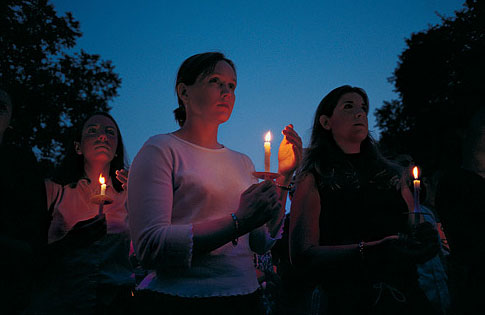
Men and women struggled individually to absorb what had happened and what it meant. In the hours following the attack, students phoned parents, prayed, wept, talked, and leaned on one another. "I feel I am insulated here," one freshman, a college student for less than two weeks, reflected a week later. "I can throw myself into my classes, into my studying and reading, and I can ignore what has happened. I am ashamed of that ability in myself."
But the carnage was too great to ignore for long. When the first plane hit One World Trade Center in New York City, Raymond Rocha '95 had been working on the 105th floor as a Cantor Fitzgerald bond trader for only a month. He was one of about 1,000 Cantor Fitzgerald employees working on four floors of the tower near the plane's point of impact. More than 700 of them are now presumed dead, including Rocha.
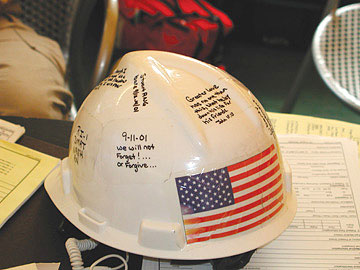
On the twenty-first floor Dwight Woodson '66, a general manager for the Port Authority of New York and New Jersey, had felt the entire building shake when the jet had struck. Rushing from the conference room where he'd been meeting with colleagues, he could already see the office filling with smoke. Later he remembered glancing out the windows and seeing "all kinds of things" falling. After moistening paper towels to filter the air entering their lungs, he and about a dozen colleagues looked for a way out. He, too, saw that the wall of the elevator bank had broken apart. They rushed to a stairwell and joined the procession of people rapidly descending. Somewhere near the eleventh floor he saw a cafeteria full of people just sitting there; Woodson and his colleagues yelled for them to get out. By the fourth or fifth floor, people were slipping on water that had accumulated from the overhead sprinklers. At the mezzanine level he saw people whose clothes had been burned off and firefighters ascending the escalators. On one window, he said later, were "massive amounts of blood."
Driving along FDR drive on her way to work at City Hall, Lynn Rasic '98 answered her cell phone and learned from a colleague that the north tower had been hit. She turned on the radio and in the distance could now see the smoke rising from lower Manhattan. Then she saw a second plane flying toward the World Trade Center from the south. At first Rasic, a deputy press secretary for Mayor Rudolph Giuliani, figured the plane was part of a rescue effort. Then she saw it enter the second tower.
Inside Two World Trade Center at that moment, in the eighty-ninth-floor offices of the investment firm Keefe, Bruyette & Woods, researcher Paul Sloan '97 was calling his mother in California to assure her that he was not in the north tower, the one that had been hit. After that, Sloan, a former Brown football teammate and Delta Tau fraternity brother of Raymond Rocha's, spoke on the phone to a few other relatives and friends to let them know he was fine. Four floors below him, at the law firm of Harris Beach, Joanne Weil '84 had just begun settling into her workday when the first tower was struck. Weil, one of the newest of the fifty lawyers employed in the office, had begun her job barely six weeks before. And one floor down from her, Andrew Soloway '86, a veteran of the 1993 World Trade Center bombing, was sitting at the trading desk of Euro Brokers Inc. Although some fire marshals throughout Two World Trade Center were telling people they were safer inside the building than outside, where huge chunks of the north tower were tumbling to the streets, the marshal on Soloway's floor urged everyone to get out. Remembering the trauma of the bombing eight years earlier, Soloway headed quickly for a stairwell and down.
While he was pausing on the fifty-fifth floor, United Airlines flight 175 roared into his tower. "When that plane hit," he recalled later, "I'd never felt anything like it. The floor just buckled." A wave of dust and debris pushed him back into the stairwell. When he exited from the tower, he was horrified: "It was complete carnage," he said a few days later. "There were chunks of bodies, pieces of the plane and building. The police were telling everyone to run." Among the people running was Louise Quick Spann '82, an attorney for the New York Stock Exchange whose office was on the twenty-ninth floor. She had been on her way into the building when the first plane hit. "I heard this ridiculously loud explosion," she remembered a few days later, "and I [looked up and] saw the building in flames and the smoke." She began to run. "You're just sort of running. You don't really have any concept of where you're going or whether you're going to be safe. I felt the whole place was rigged. You just felt like [bombs] were going off one after another." Strangers among a sea of sobbing, suffering strangers, Soloway and Spann and Woodson ran. Paul Sloan and Joanne Weil were still inside the tower. They did not make it out.
Helped occasionally by other people making their way down the stairs, Benfante, Cerqueira, and the woman in the wheelchair, meanwhile, had made it almost to the fortieth floor. Firefighters working their way upward told them they could drop the woman off at a first-aid station on the twenty-first floor.
No, the woman said to the two men, "Take me out of here."
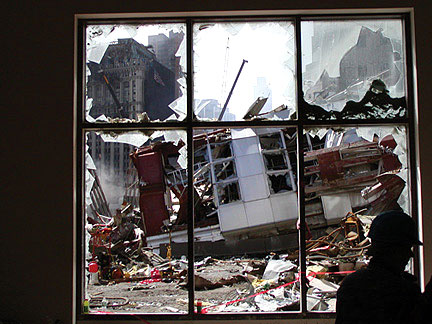
Having safely made it out of the first tower, Dwight Woodson ran to Battery Park, wondering as he was enveloped by a cloud of debris about the safety of his son, a student at New York University just a few blocks away. Soloway, who lives in Short Hills, New Jersey, headed for his brother's apartment on 41st Street. Louise Spann kept running until she was near Union Square, then found a bus and eventually a taxi, whose driver took her and her fellow passengers all the way up to Harlem; the driver then turned off the meter and drove her to her home in New Rochelle. Woodson, after learning that his son had been safely evacuated from NYU, headed on foot for his house in Demarest, New Jersey, walking, with thousands of others, across the George Washington Bridge. Over the next few days Spann learned that all her coworkers were safe. Woodson was told that seventy-four of his fellow Port Authority employees had been lost, and Soloway discovered that of the 285 people in his office, sixty were now missing, including five of his colleagues at the trading desk.
Lynn Rasic, meanwhile, had gone to City Hall and departed from there on foot toward the World Trade Center. She had learned that the mayor was near the WTC and was not sure whether he was dead or alive. Eventually she entered a restaurant on Broadway, found a phone, and reached a colleague who was with Giuliani. After learning where he was, she walked down to join him at a fire station in the West Village. "He really had everything under control," she remembered a month later. "He was already directing people."
Once on the street outside One World Trade Center, Michael Benfante and John Cerqueira looked up to see the tower in flames. It was then they realized that only a jagged piece of Two World Trade Center was left. "Let's get out of here," Cerqueira said, but they were soon stopped by a reporter and interviewed. Suddenly they heard another explosion and realized that One World Trade Center was caving in, releasing a huge dark cloud of debris. Benfante and Cerqueira began running north up the West Side Highway. As the cloud approached, they dove under a parked truck, where others had taken refuge. As the wave of debris, smoke, and particles of glass went by, the world turned suddenly black and quiet. Breathing, Benfante later said, "was like sucking ash through a straw." A man beside him, who turned out to be a firefighter, told him to stay down, and after a long five minutes Benfante and Cerqueira crawled out and resumed their run to the north, turning east into the streets of lower Manhattan. Near 14th street, Cerqueira spotted a church. The two men entered and began to pray. "I just thanked God," Benfante later said. Eventually he would learn that everyone from his office was safe.
About a half-hour after the second World Trade Center tower was hit, American Airlines flight 77 hammered into the southwest face of the Pentagon. Among the 189 people killed in the plane and in the building was Dave Laychak '83, a civilian budget analyst for the U.S. Army. Laychak, another former Brown football player and Delta Tau brother, had met his wife, Laurie, in the Pentagon seventeen years before. When the plane hit, she said a few weeks afterward, "he was literally at ground zero." About twenty minutes after the hijacked Boeing 757 had flown into the Pentagon, a struggle apparently broke out inside United Airlines flight 93 as it flew over a rural landscape about eighty miles southeast of Pittsburgh. Weeks after the plane plunged into a field there and disintegrated, the FBI confirmed that the struggle had been between hijackers who had taken over control of the plane and several passengers who had learned via cell phones what had happened in New York City. The passengers, determined to prevent another plane from becoming a deadly missile, had died foiling the hijackers' well-rehearsed plans. One of the passengers on flight 93 was a former Brown wrestler named Donald Greene '71, who was en route to a hiking vacation with his brothers at Lake Tahoe. His friend and colleague Peter Fleiss later said that Greene, executive vice president of a company called Safe Flight Instrument Corp., was an experienced pilot. Had the passengers been able to regain control of the plane, he would have been capable of flying it to safety.
Among the first wave of firefighters arriving at the World Trade Center on September 11 was Charles Margiotta '79, a lieutenant with the Fire Department of New York and a former Brown football lineman, who, his brother later said, "never wanted to be a suit-and-tie guy." Margiotta had been on his way home from a twenty-four-hour shift in Brooklyn, where he'd been filling in for a friend, when in the distance he saw smoke pouring out of One World Trade Center. He pulled into the nearest fire station, Rescue Company 5, and joined the members of the company as they headed for and eventually entered the towers. Margiotta was one of the 343 firefighters who never came out.
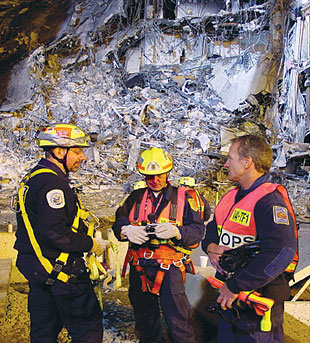
Also on the night of September 11, one of Hanfling's Brown Medical School classmates, Selim Suner '86, '92 M.D., was assembling his Rhode Island Disaster Medical Assistance Team in Providence. After loading four trucks with field hospital supplies, Suner and more than fifty physicians, nurses, and other medical personnel‚ including several Brown Medical School professors, students, and staff members‚ drove under state-police escort to Stewart Air National Guard Base in Newburgh, New York, from which the federal World Trade Center rescue effort was being directed. Suner's team arrived in lower Manhattan on the night of September 12, setting up field hospitals in tents and in a deli on Church Street. For the next two weeks Suner and his team remained at ground zero, treating rescuers (and the occasional rescue dog) for a variety of physical and psychological injuries. "We saw a lot of smoke inhalation and a lot of eye irritation," Suner reported later. "We saw broken bones, we saw firefighters and police officers walking deliriously around the site."
Back on the Brown campus, faculty, staff, and students tried to absorb what had happened. Administrators tried to determine whether anyone on campus had an immediate family member among the missing and the dead. (Miraculously, no one did.) At noon on September 11, more than 100 students, faculty, and staff gathered for silent prayer in the brilliant sunshine on the front steps of Manning Chapel. As people slowly joined their colleagues and friends, some hugged one another, but most stood silent, lost in their own thoughts and occasional tears. Drawn by the need to pause, to reflect and, possibly, to pray, no one seemed to know what to say or what to expect. President Ruth Simmons emerged from University Hall to offer comfort to individuals here and there, but it was University Chaplain Janet Cooper-Nelson who addressed the gathering.
"We stand together to say we simply stand and live," she said, reminding those gathered that, although not all may believe in God, this was a good time to remember Brown's motto, In Deo Speramus, and the hope it contained. "I think in the face of this kind of tragedy, hope is the dearest gift we have. When we come together, we are hoping literally that all the people we love are safe and are not victims. And we are hoping that somehow this kind of violence will not take away our sense of safety and security about what can be in the world." She added a note of caution about not marking the day "with unspeakable acts of stereotyping and glorification of blame and scapegoating‚" and asked everyone to observe five minutes of silence. After the five minutes were over, people clustered together in small groups and began to pray and talk quietly with one another, taking the first tentative steps toward finding meaning in what had taken place that morning.
Classes continued to be held, but President Simmons made it clear that students would not be penalized for missing them if that was what they needed to do. Some professors focused their discussions that day on the events of the morning, while others believed that to continue with the mundane business of conducting a normal class would be the greatest act of defiance against terror.
That night a much larger group of students, faculty, and staff assembled in the Salomon Center and overflowed onto the Green to seek reassurance and guidance from President Simmons, from faculty members, and from one another. "In the course of the day," Simmons told the students, "we have moved from shock and despair to grief and disbelief. We have become aware more than ever of our helplessness against the sinister force of hatred." It was an emotional gathering. Students read poems, and one commented that she felt it had been disrespectful not to cancel classes for the day. Simmons responded that she had made that decision because of her belief that "it would be better for us to be together in our activities, rather than [alone] in our rooms or in our homes." Speaker after speaker urged the group not to act rashly or to jump to judgment. "An unjust response to an unjust action does not make justice," said political science professor P. Terrence Hopmann.
"There are regions of the world that we understand not," Simmons said. "There are peoples of the world that we care not to know. There are communities in our very midst from which we turn away. Turning away is not a solution. While it is too early to say who is to blame for the horror visited upon the nation today, we can surmise that this horror is the result of a misbegotten scheme to call attention to some cause, some offense, some grievance. One of the powerful things we can do to counter this kind of event is to use peaceful venues of debate and grievance. We can make every effort to learn how to abate conflict and how to repair breaches in human accord."
As the days passed, people across campus sought ways both to continue with their academic lives and to do something, anything, that would matter. The Red Cross set up a blood-donation center on three consecutive Fridays. On Thursday, September 13, hundreds of students flooded the main Green for a candlelight vigil memorializing the victims of Tuesday's attacks. Also that night, while students snacked on cheese, crackers, and fruit, five faculty members held a forum in the Salomon Center on war and terrorism. The auditorium could not accommodate the huge turnout, and so the forum had to be simulcast to other buildings on the Green. The scholars' message was clear: the United States should fight terrorism but not at the expense of innocent civilians or of the liberties and values that the country has always held dear. Professor of International Relations James Der Derian said, "As the grieving subsides and the call for action gets louder, I hope we respond with our best selves, not our worst instincts."
Gradually shock gave way to other emotions: grief, anger, fear, disillusion, and love. Individuals got their footing and found themselves members of communities: firefighters, police officers, rescue workers, Arabs, Americans, Muslims, Sikhs, Democrats, Republicans, colleagues, friends, and families. Each community traced its connections to 9.11.01, discovering the web of cracks that had suddenly appeared in the societal landscape. For the two weeks following September 11, messages and peace signs appeared in colored chalk on the sidewalks that cross and surround the Green:
NOT ONE MORE VICTIM ANYWHERE
I SUPPORT MY PRESIDENT
PEACE IS GOOD, PEACE WITH JUSTICE
IS EVEN BETTER
SUPPORT USA
There were sporadic attempts at rousing a peace movement, but the turnout at rallies and protests suggested that most students just weren't in the mood right now. On September 20, about 200 students observed what was billed as a "National Day of Action." Speakers, while expressing grief over the victims of September 11, urged that, in the words of one student, "the best way to honor their memory is to not kill more people." Phil Neff '05, who stopped by the event, seemed to speak for the majority of students when he told the Brown Daily Herald: "I think not acting against the terrorist attacks shows that we're willing to stand by and let something like this happen. I don't think that declaring war on a specific nation is necessary, but I think we have to punish whoever did this using whatever means necessary. The talk of peaceful justice is going to get us nowhere right now." Also at the rally was Kaizar Campwala '02, a Muslim student who was quoted in the Herald as saying he'd received hateful e-mails. Like most Americans, Campwala wanted action but was not entirely sure what kind. "Something should be done to [whoever did this]," he said, "but not to Afghanistan."
Many students and administrators expressed concern for Arab Americans and Muslims generally, but as Arab students on other campuses were reported to be withdrawing from their schools and returning home, Brown's director of foreign students, John Eng-Wong, reported that the 100 or so Arab or Muslim students at Brown were feeling little fear. "I'd like to think that because of the place we are," he said, "we've created a welcome for students from around the world--even before the events of September 11." Professor of History Engin Akarli, an expert on the Middle East, echoed Eng-Wong's belief when he said, "I can assure you with some authority that our students haven't experienced bad incidents. Some felt disturbed that something might happen, but they didn't experience any problems."
Faculty, meanwhile, tried to do what Brown professors do best: teach. Panels were formed to talk about Pakistan and global security, about media bias, and about Islam. All were well attended. A white memorial wall was set up on the Green to allow faculty, students, and staff to record their thoughts and feelings. As September turned to October, the memorial was taken down and life on campus began returning to normal, but after the first bombs fell in Afghanistan, concern and anxiety never seemed far from the surface. On October 9, a new group, Not Another Victim Anywhere, invited students to walk out of their classes at 11:30 a.m. and rally on the Green. "We cannot simply go on with our daily routines as our country prosecutes an unjust war," organizer Shaun Joseph '02 told the 120 people who gathered near the flagpole. (The flag had been returned to full-mast a few days before.) "Students are walking out in solidarity with the people of Afghanistan, who must now suffer the double burden of a dictatorial regime and American bombs." Nearby, a dozen students held a counter demonstration, waving U.S. flags. The two groups briefly shouted at each other until it was time to get back to class. After they departed, the Green, whose elms were just beginning to take on their fall colors, returned to what it has long been: a place to cross en route to class, a verdant sanctuary on which to study, to talk, and to play.
As the weeks passed, the families of the six Brown alumni who had died in the September 11 attacks tried to deal with their loss. Among them six children, ranging in age from six to thirteen, had lost their fathers. Three wives were now widows.
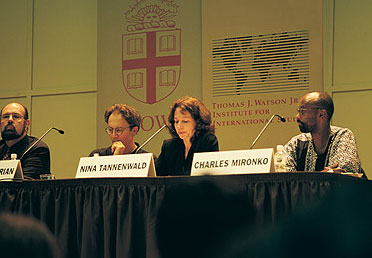
Andrew Soloway was slow to return to work, vowing to wait until all the memorial services for his colleagues had been held. In the weeks after the attack he found himself afraid to enter tall buildings. As for flying, "I'm not getting on a plane," he said a few days after fleeing his office. "There's no way in hell." Having survived the 1993 bombing and this latest horror, Soloway says, "I figure I've got one more strike."
A month after the attack in New York City, life took on enough normalcy for some of the smaller effects of the tragedy to sink in. Neither Louise Spann nor Dwight Woodson was ready yet to return to ground zero, but it has never been far from their minds. Spann, who prosecutes violations of New York Stock Exchange regulations, gradually became aware of the effect of the towers' collapse on her work. "All the computers, all the documents are gone," she said. "No one accused of a security violation is going to say to me, 'Okay, here’s another copy of that incriminating document.'"
Woodson, whose new office is in Hoboken, New Jersey, has found the day's events inescapable. Reading the Hoboken newspaper, he discovered that forty-two people in that city alone had perished in the towers; thirty-nine of them, he said, were under the age of forty. And the smallest, most mundane acts seemed to lead back to lower Manhattan. "I was going to play bridge this last weekend," he said during the second week of October, "and I thought, 'I've got this neat little book about bidding in bridge. I think I'll bone up on it before I play.' Then I remembered. It was back in my office in New York."
Norman Boucher is editor of the BAM. Much of this article is based on reporting by Senior Writer Emily Gold and Staff Writer Zachary Block '99.





